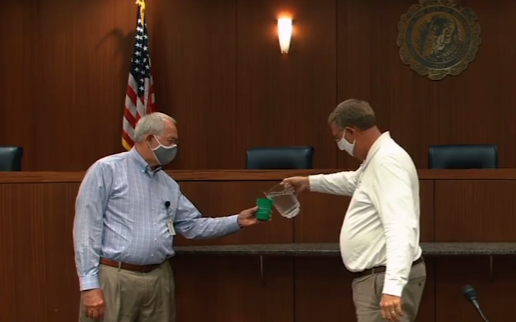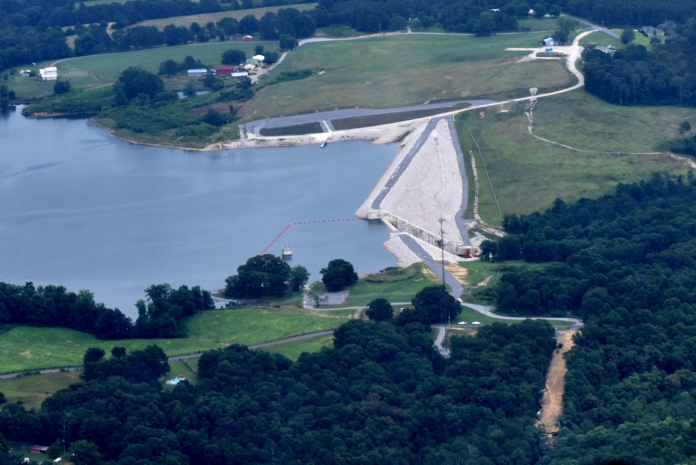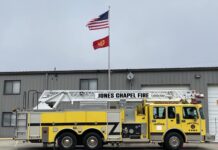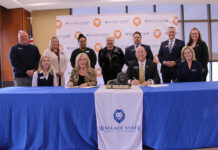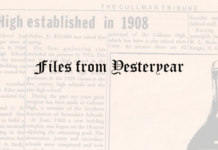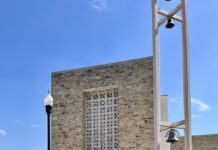CULLMAN, Ala. – Mayor Woody Jacobs announced Friday, July 17 that the city of Cullman has begun drawing water from the Duck River Reservoir to the city water treatment plant, and that the city is now receiving drinking water from the reservoir. During his Friday video update, Jacobs invited Cullman Economic Development Agency (CEDA) Director Dale Greer to attend, and poured him a cup of water drawn from the new supply.
Jacobs said, “Today I am excited to say that water from Duck River is now being pumped to the water filter plant and coming to a home near you.”
The mayor thanked Greer for his 27 years of service in the development of the project.
Greer, who came to work for Cullman in May 1993, told The Tribune, “It really is 27 years of culmination on a project that I always believed had the potential to ensure this community had an adequate water supply for a hundred years. It protected not only the residents, but businesses and agriculture- particularly the poultry industry- and so many other things that are important to us. It allows us to continue to grow and prosper in the future.”
At the June 26 Cullman City Council meeting, Jacobs recounted his experience during the 2006 drought and his reaction at seeing how drastically Lake Catoma fell. He said even though there has not been another drought as intense since then, it could happen again at any time, and that year really drove home how necessary another water source would be.
“This has been a long time coming, and it’s been a lot of work to get here,” said Jacobs. “There’s been some environmental folks who didn’t want this to happen, and it really cost the rate payers some money. We could’ve built this impoundment, the debt would be half paid off and we could’ve built it for cheaper, but that’s not the reality. The reality is that it’s built, the pipeline is complete, next week they’ll be flushing lines and by the end of the week, they can begin treating some of that water.”
Jacobs beamed, “It’s a great day for all of Cullman County – all the rate payers, chicken houses, farms – and we couldn’t have done it without everyone in this room.”
As Cullman’s city government celebrates the opening of drinking water service from Duck River, The Tribune takes a look back at the projects that led to this point.
Cullman’s water system
Cullman’s city water system dates back to the 1887 drilling of an artesian well fitted with a steam-powered pump to support industrial water needs. By 1913, the city had three wells with a capacity of 72,000 gallons per day.
In the 1930s, droughts forced the transportation of water to Cullman by truck, until a pipeline was run from the Mulberry River in 1938. An 80 million-gallon, 18-acre lake was impounded at Eva Road Bridge in the late 1940s. Neither of these is still in use.
The City impounded Lake George as a water source in 1958, creating a 254-acre reservoir with a potential 5 million gallon-per day supply. Lake Catoma followed in 1967 with a new treatment plant; Lake George was disconnected from the water system and the old treatment plant was closed.
Jimmy Knight, chairman of the Duck River Advisory Board, addressed the Cullman City Council June 26 about the recent history of the water systems in Cullman County.
Said Knight, “Cullman is on a plateau, and having a source of water for the public has been an issue ever since it was formed. Back in the 60s, Mayor Bill Nesmith and a lot of others had the vision to build Lake Catoma. He said it could produce 8 million gallons a day, and at that time they were using 3 million gallons a day. Most of us were raised where we had an outdoor toilet, didn’t have running water, and a public water supply just seemed out of the question. But the people at the East Cullman Water System started it, said they’d borrow some money, and built a water system to East Cullman. Then it went to VAW (VAW Water System Inc.), then through Johnson’s Crossing, and then to Walter, then the County got into the water business in 1972.”
In 1992, the County received a $5 million grant from the Appalachian Regional Commission to develop an alternative and emergency water supply for the county’s poultry industry. The City kept the grant open and drew from it as needed for the next 25 years.
According to Greer, “That grant made it possible for us- and by ‘us’ I mean this community and all the people and all those things- that you could continue to work the project because you had money. Most people, when they were in that situation, then they would say, ‘Well, it would cost X if we had to do this.’ Somebody was having to budget that money and do it again. Well, we had that money that we could draw down for years, and it took us a long time to go through $5 million. But whenever something would come up and the Corps of Engineers or EPA or whoever was in authority would say, ‘Well, y’all need to do X before you can move forward,’ we had the ability to pay for moving forward when most people would not. I think without that grant, it would have been highly unlikely that you could have kept the project going as long as it continued.”
A nine-member advisory board formed in 1993 considered long-term water needs in Cullman and Morgan counties, especially for agricultural industries. Among the solutions they considered were:
- Piping water from two locations on the Tennessee River
- Drawing from one of two dams on the Mulberry River
- Drawing from a new dam above Lake Catoma
- Drawing from a dam on Brindlee Creek
- Drawing from a dam on Flint Creek
- Piping water from Smith Lake
- Drawing from wells
Smith Lake is a man-made reservoir built by the Alabama Power Company between 1957 and 1961 to generate power at Lewis Smith Dam. Water is sent from the lake to Jefferson County via a pipeline. The Smith Lake option was popular in Cullman County, but opposed by the Alabama Power Company which already drew from the Smith Lake drainage basin. The final recommendation made by the U.S. Army Corps of Engineers was to build a 135 foot high, 2,000 foot long dam across the Duck River between Berlin and Holly Pond, to create a then-predicted 650-acre reservoir surrounded by a 100-foot natural vegetation buffer with limited access, with a predicted water output of up to 32 million gallons per day for the next 75-100 years.
An important and attractive feature of the Duck River plan was the ability to link it with Lake Catoma at a single facility, allowing operators to choose their source, use one as an emergency backup to the other or blend water from the two to improve incoming water quality.
Over the years, the Duck River project weathered two federal lawsuits from groups arguing that Duck River must be maintained as a navigable waterway, and a third suit brought by two county commissioners who were trying to establish a separate county water authority.
The Utilities Board began issuing $58 million in bonds to fund the project in 2011.
Purpose of the dam and reservoir
According to a document from the Utilities Board of the City of Cullman supplied to The Tribune in 2017, “The purpose of the Duck River Dam is to create an approximately 640-acre reservoir that will serve as a raw water source.”
Greer offered more detail, telling The Tribune, “(The) purpose was to construct a dam to create a reservoir to impound water to serve as backup source and future supply for the area. Previous engineering studies had indicated Lake Catoma was not sufficient to continue to meet the water supply needs of the residential, commercial, industrial and agricultural needs of Cullman County. During the 2006 drought Lake Catoma was down 26 feet below full pool and the lake was not sufficient to meet our need for another 60 days. Even the most doubting individuals saw the forecast of a looming water shortage in Cullman County was accurate without a new supply source. The community growth in the past 10 years would imply our water needs will continue to grow.”
Pipeline project
An intake tower near the dam draws water from the reservoir to be pumped out to the treatment plant for conversion to drinking water via a pipeline system between the dam and plant.
In June 2016, the Cullman County Commission and City Utilities Board signed an agreement that would, according to then Cullman County Engineer John Lang, “govern the perimeters surrounding the water line installation that will go from the new reservoir to the water treatment plant.” Lang stated at that meeting that the agreement also provided that any portions of roads affected by the construction would be restored to “as good or better condition than what they found it after they get done completing the work.”
The pipeline exits the lake near the intake tower in the reservoir just north of the dam, and crosses County Road 1640 before turning south toward U.S. Highway 278. From there it runs along the north side of the highway, crossing to the south east of Berlin and running through that town under County Road 735, where the pipeline was laid during a repaving project. On the Cullman side of East Point, the pipeline turns north and west to take it into the Cullman Water Treatment Plant.
Some speculated that the pipeline project would be used to annex the then unincorporated Berlin community into the city of Cullman, but Greer explained, “There was a lot said that the City of Cullman would use that pipeline to incorporate Berlin and other properties, but Alabama law prohibits easement use for that purpose.”
The delay in timing between the dam and pipeline was part of the Utilities Board’s plan. Since the reservoir was going to have to undergo a year of water quality monitoring before the board could begin pumping water to the treatment plant, and the million dollar-plus pumps had a one-year warranty, the board decided to delay the installation of pipes and pumps until the time for their use was closer.
2015 flood reveals flaw in dam, leads to new lawsuit
A flood on Christmas Day 2015 put the dam to its first major test of strength and, unfortunately, it did not fare well. “At that time,” according to papers filed by Cullman City Attorney Roy Williams as part of a 2017 lawsuit against the dam’s construction company and design engineers over the leakage, “a far greater than anticipated flow of water from the reservoir into and through the concrete portion of the dam was first observed (‘Excessive leakage’). Much of the excessive leakage flows into and through the gallery.”
The gallery is an internal access thoroughfare that allows inspections and repairs to be made inside the dam. It was later found that water had risen high enough inside the dam to contact and damage electrical wiring, leading to a shutdown of the electronics that control the dam’s gates and valves.
In a 2017 message to The Tribune, City officials stated that water release valves “can currently be operated, but only by using a temporary generator. After soliciting bids, the Board awarded a contract for remediation of the dam’s electrical systems and some equipment components.”
Lawsuit
In July 2017, Williams, on behalf of the Utilities Board of the City of Cullman, filed suit against CH2M Hill Engineers, Inc., ASI Constructors, Inc. and Western Surety Company for deficiencies discovered in the Duck River Dam. CH2M Hill designed the dam, and ASI built it; Western Surety issued ASI’s required performance bond, guaranteeing the successful completion of the project.
ASI asserted that the leakage was due to deficiencies in CH2M’s design. CH2M, in response, defended its design and contended that the problem was with ASI’s construction.
Whoever is at fault, the fact remains that Duck River Dam has a problem. Greer, who briefed the media on the suit in 2017, offered assurance at that time that the dam was in no imminent danger of catastrophic failure; two independent engineering firms had inspected the structure and agreed that the dam was safe.
Even though safe from collapse, the dam, according to litigation paperwork, “cannot be operated or used as intended, and continues to require extensive and expensive monitoring, investigation, and maintenance that exceeds any routine upkeep contemplated by CH2M’s design documents and the ASI Construction Contract (prepared by CH2M). Because the Duck River Dam cannot be operated and used as intended, the reservoir itself cannot be used as intended.”
The fix may be as simple as extra waterproof coating on the face of the dam, or sealant in the joints between structural components. At one point, ASI was poised to attempt those measures, when it suddenly pulled out of the project. After that, ASI Constructors sold all of its equipment and assets, then declared that it is no longer able to continue work on the project. Western Surety wrote to the Cullman Utilities Board, according to the litigation paperwork, that “as far as Western Surety was concerned, ‘ASI no longer exists.’”
ASI Constructors, Inc., however, sold all its assets to a company named ASI Construction, LLC headquartered in the same city (Pueblo West, Colorado). Web searches for either name lead to the same website, on which both names occur.
Western Surety, for its part, declared that the bond it issued did not include corrective work to the dam, therefore it had no liability in the matter.
As the two companies and bond issuer would not agree on who is responsible for the problem, the City of Cullman hopes that the suit will help sort out who needs to do what. More importantly, city officials hoped that whatever needs doing will actually get done.
Said Greer, “The Utilities Board and the water customers don’t build dams, they don’t do construction, they don’t do design engineering. The two of those should not be responsible for making sure that you have a quality product. It should be done by those others (CH2M, ASI).
“What we’re asking the court to do, and it’s filed in Cullman County Circuit Court, is not award us money, not do any of those things; but to help us identify which of those is actually in breach of contract, whether it’s the general contractor or whether it’s the design engineer, or it’s the insurance bonding company for us; and to direct whichever one of those it is to correct that problem for us, so that we end up with the product that we were intended to have, and that we’re able to provide the water and generate the things that we need.”
The lawsuit is still pending, and repairs to the dam are also waiting on settlement of the question of who will pay.
Reservoir opens
On July 17, 2018, the City of Cullman officially opened the Duck River Reservoir to boats and fishers and opened the 22 miles of interconnected bicycle and hiking trails that encircle the lake.
Greer told the assembled crowd, “Today we celebrate the aspects that have been created other than the drinking water supply. Having the drinking water supply was really, really important, but if you didn’t do something with the recreation potential on this reservoir, that really, really would’ve been a shame. It was part of the Corps of Engineers’ plan that we had to do that, but what we have prepared and done as a community is much beyond what was required of us, and I really, really am proud of what’s here.”
The reservoir contains (naturally or by stocking) the following fish species, listed with their current catch limits:
- Florida and Alabama Bass – catch and release only
- Bluegill and Redear Bream – maximum 20 fish of any size
- Black Crappie – maximum 30 fish which must be 9 inches or longer
- Channel Catfish – no limit. This is a young population that is considered not large enough to catch, yet.
Reservoir Manager Tim Scott insisted that, because the lake and its fish populations were still maturing, fishing limits would be strictly enforced. Fishing piers are located at certain points around the lake, and fishing is allowed from boats. Motorized watercraft are limited to engines of 25 horsepower or less.
Fishing requires a permit, which is available in a box near the boat launch, or which can be downloaded via link from www.cullmanal.gov or from the Duck River Facebook page (www.facebook.com/Duck-River-Reservoir-Project-134002529946659).
Pump station
The Utilities Board began advertising for construction of the pumping station at the reservoir in November 2018, and construction was to begin after the opening of bids that December.
According to information given to The Tribune by General Manager Mike Manning, construction would take up to a year, and, at that time, the board hoped to have water running to the plant by the end of 2019.
The construction project included three 500-horsepower motors with a 60-80 horsepower “jockey pump” that can move up to 1 million gallons per day to the plant. The larger pumps can move large amounts of water quickly, in case pumps from Lake Catoma need to be shut down, or if blending the two sources can increase water quality at the plant.
Bonds to be paid off, resulting in projected lower water rates
On June 26, 2020 Jacobs announced that the City will begin paying off bonds sold for the Duck River project in 2011, at a savings of $20,490,238.09. Because of this, water rates for city residents are predicted to decrease. The amount of that decrease was not specified.
“Every year when we calculate the water rates, they’ll be a little cheaper,” said Jacobs.
Look for more on the Duck River reservoir, dam and pipeline projects coming tomorrow.
Copyright 2020 Humble Roots, LLC. All Rights Reserved.
